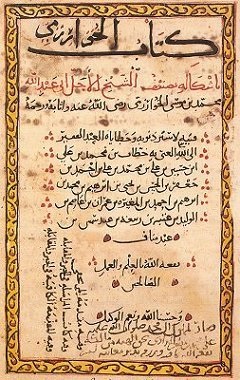|
|
| |
|
|
| |
|
|
|
|
| |
 |
| A page from al-Khwārizmī's
Algebra. |
Mathematics
Mathematics is the study of numbers, shapes and
patterns. The word comes from the Greek word "μάθημα" (máthema),
meaning "science, knowledge, or learning", and is
sometimes shortened to maths (in England, Australia,
Ireland, and New Zealand) or math (in the United States
and Canada). The short words are often used for
arithmetic, geometry or simple algebra by students and
their schools.
Mathematics includes the study of:
Numbers:
how things can be counted.
Structure:
how things are organized. This subfield is usually
called algebra.
Place:
where things are and their arrangement. This subfield is
usually called geometry.
Change:
how things become different. This subfield is usually
called analysis.
Mathematics is useful for solving problems that occur in the
real world, so many people besides mathematicians study and
use mathematics. Today, some mathematics is needed in many
jobs. People working in business, science, engineering, and
construction need some knowledge of mathematics. |
|
Problem-solving in
mathematics
Mathematics solves problems by using logic. One of the
main tools of logic used by mathematicians is deduction.
Deduction is a special way of thinking to discover and
prove new truths using old truths. To a mathematician,
the reason something is true (called a proof) is just as
important as the fact that it is true, and this reason
is often found using deduction. Using deduction is what
makes mathematics thinking different from other kinds of
scientific thinking, which might rely on experiments or
on interviews.
Logic and reasoning are used by mathematicians to create
general rules, which are an important part of
mathematics. These rules leave out information that is
not important so that a single rule can cover many
situations. By finding general rules, mathematics solves
many problems at the same time as these rules can be
used on other problems. These rules can be called
theorems (if they have been proved) or conjectures (if
it is not known if they are true yet). Most
mathematicians use non-logical and creative reasoning in
order to find a logical proof.
Sometimes, mathematics finds and studies rules or ideas
that we don't understand yet. Often in mathematics,
ideas and rules are chosen because they are considered
simple or neat. On the other hand, sometimes these ideas
and rules are found in the real world after they are
studied in mathematics; this has happened many times in
the past. In general, studying the rules and ideas of
mathematics can help us understand the world better.
Some examples of math problems are addition,
subtraction, multiplication, division, calculus,
fractions and decimals. Algebra problems are solved by
evaluating certain variables. A calculator answers every
math problem in the four basic arithmetic operations. |
|
Areas of study in
mathematics
Number
Mathematics includes the study of numbers and
quantities.It is a branch of science the deals with
logic of shape,quantity and arrangement. Most of the
areas listed below are studied in many different fields
of mathematics, including set theory and mathematical
logic. The study of number theory usually focuses more
on the structure and behavior of the integers rather
than on the actual foundations of numbers themselves.
Structure
Many areas of mathematics study the structure that an
object has. Most of these areas are part of the study of
algebra.
Shape
Some areas of mathematics study the shapes of things.
Most of these areas are part of the study of geometry.
Change
Some areas of mathematics study the way things change.
Most of these areas are part of the study of analysis. |
|
|
|
|
|
|
|
|
|
|
|
|
|
|
|
|
|
|
Search Fun Easy English |
|
|
|
|
|
|
|
|
|
|
|
|
|
|
|
About
Contact
Copyright
Resources
Site Map |